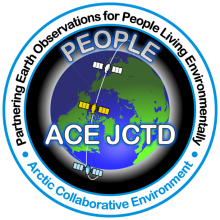Information about all research and exploration in the Northwest Territories (NWT) has been collected since at least the 1950s. Licensing first began with the federal government, then in 1984 the territorial government took over the responsibility with the implementation of the NWT Scientists Act. This data is now compiled and stored by the Aurora Research Institute, the organization responsible for administering the NWT Scientists Act. This branch of the ACE project seeks to improve the public ease of access to historical NWT licence information, which will increase its usefulness. The ACE tool will also allow users to layer, view and manipulate many geo-referenced data sets together; which can provide additional insights for people looking to do research, operations, and education in the NWT and the broader Arctic.
About the ACE Project:
The Arctic Collaborative Environment (ACE) application tools project focuses on providing an open-source, centralized visualization, real-time data collaboration and data collection exploitation capability that is designed for use of maritime and terrestrial environmental intelligence geo-referenced situational status, observations, imagery, modeling data on a regionalized basis.The NASA led joint DoD and NASA/Marshall Space Flight Center (MSFC) ACE project is an Office of Secretary of Defense Joint Capabilities Technology Demonstration between NASA Marshall, The U. S. Army Aviation and Missile Research Development and Engineering Center (AMRDEC) and the International Arctic Research Center, University of Alaska Fairbanks to enhance awareness and understanding of the Arctic environment in support of international and domestic research, disaster and humanitarian response situational awareness, operations, and education. ACE is comprised of two major application tools developed by Marshall, AMRDEC and the University of Alaska Fairbanks – the personal computer web-based application and a mobile application for use in the field.
NASA Marshall manages the technical and programmatic execution of the overall project and is leading the development of the personal computer web-based application tool in partnership with the International Arctic Research Center at the University of Alaska, Fairbanks. AMRDEC is leading the prototype handheld mobile application tool development. Currently, other AMRDEC applications programs provide a wide array of mobile handheld technologies, hardware and software applications, and products and services for today’s warfighter. These previous analytical science and technology developments are being leveraged with the ACE project for both the personal computer web-based and mobile application tools.
AMRDEC is creating a prototype for a handheld mobile application for the ACE project. It will be field-tested by the U.S. Army in Alaska to support disaster response and humanitarian assistance activities. The ACE mobile application allows handheld users to input data and imagery from the field to the ACE personal computer web-based users, jointly view it in relation to other data, and provide a more comprehensive perspective and understanding of the situation and the environment in which they and others are working.
Currently, the ACE tool is designed and focused on Arctic regionalization information organizing, display and collaboration. However, the architectural design approach provided for use in other regional domains. The ACE project was established as a Sustaining Arctic Observing Networks - SAON project in 2012 and was endorsed by the International Arctic Council. In addition, ACE is identified in the Executive Office of the President National Science and Technology Council five-year Arctic Research Plan as a strong partial potential solution to the gap in research cyberinfrastructure for the Arctic. ACE had more than 25 international and national contributing collaborative partnering organizations during the development phases of the project.
Aurora Research Institute involvement:
The Aurora Research Institute (ARI), with funding provided by the Von Braun Center for Science & Innovation, collaborated with NASA/MSFC to provide ACE with comprehensive public access to information on licensed research in the Northwest Territories from the past 48 years. ARI provided data layers which are displayed within the ACE JCTD tool on maps and the 3D globe (Google Earth). Information will also be organized and linked based on:
- the objectives of the research project,
- the researchers involved, and
- the year(s) in which the research was licensed.
In coordination with other projects currently in progress at ARI, users of the ACE JCTD system will be able to link to ARI’s public database of licences for further information on any given licensed research project in the Northwest Territories.
In addition, ARI has been working to bring our entire collection of public documents related to research in the NWT online. This data is also being collected for presentation through this unified interface for public access.
Planned outcomes:
The ACE application tools will support research, situational awareness, resource management studies, climate studies, education, and cooperative response to regional events such as disaster and humanitarian assistance efforts as well enhance national and international Arctic research data collaboration opportunities. For the Arctic region, the ACE application tools will enable real-time true collaboration opportunities for people in disparate areas to collectively coordinate, visualize, and discuss using automatic language translation about important data and observations as well as exchange planning information. The ACE application tools allow data, imagery, and observations to become a portal for the sharing and collaboration of Arctic knowledge and awareness. Once field-tested, the ACE tools could be easily adapted and applied to other global regions for a wide range of geo-referenced data collaborative visualization domains of interest.
Products resulting from the ACE project will be searchable and publically available. This represents a substantial dissemination of information that will be a critical resource for planning future research projects and collaborations in Canada’s arctic regions. Project deliverables will also help northern/aboriginal governments and decision-making bodies make informed decisions regarding resource development and land use planning in an environment that is being rapidly altered by global climate change.
